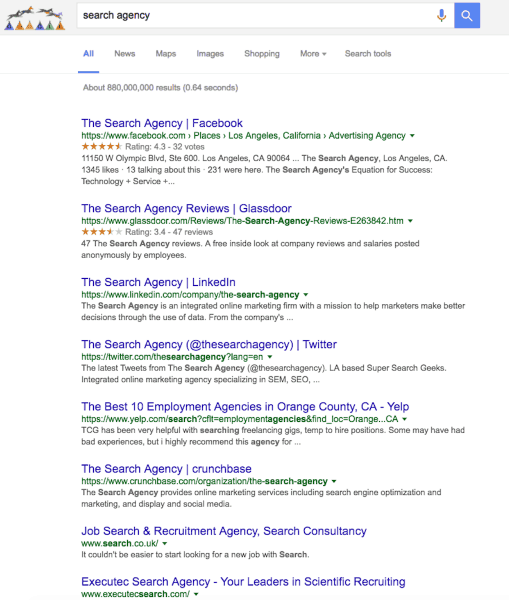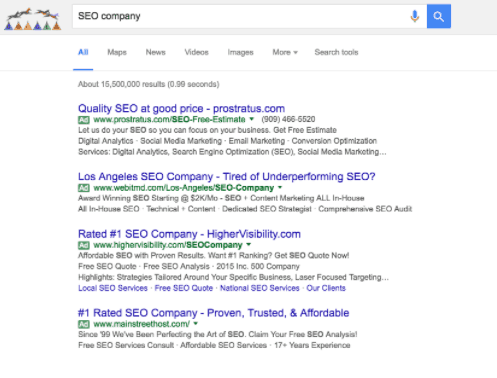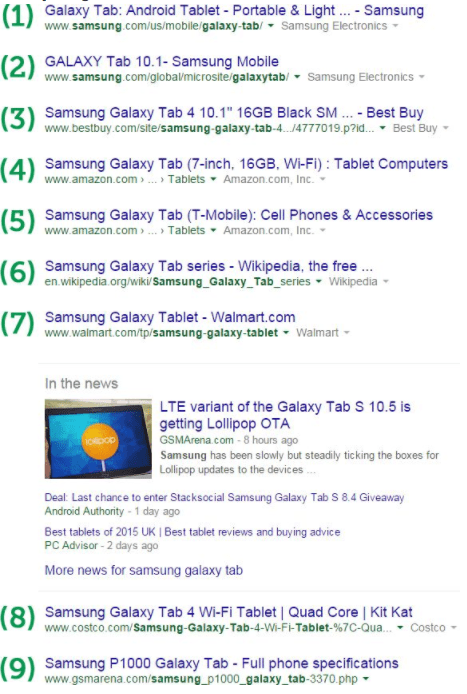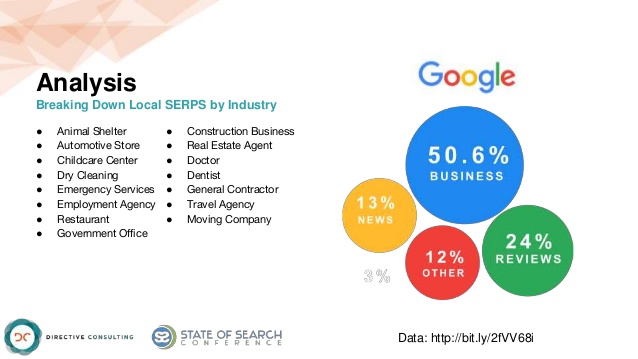Omnivores of the SERP: Eat Up More Market Share

The more universal and user-based search becomes, the more important taking up more market share on each SERP becomes.
In a constantly changing search market, the more market share you can amass, the more prepared you will be for Google’s constantly evolving search algorithms.
If you have been in the search marketing industry for more than a few years, you have seen some radical changes take place. Google has steadily been changing its format and adjusting its algorithms to better account for user behavior.
And it’s high time we search marketers start adapting as well.
If we look at an average SERP (search engine results page), we can see that the results are generally divided by four categories.

The bulk of SERP links are business websites that are offering a product, service, or content to the reader. Then there are the review sites. After these there are the relevant news bulletins and/or magazine articles. And then a few remainders that are un-categorizable.
Changing SERPs
Previously, Google used to have only 3 above-the-fold ads that would show up above the map results for a given local search. Now there are 4.
On top of that, Google has removed the side ads that used to occupy the right side of the SERP. They’ve replaced these with the Knowledge Graph Results panel that shows up for relevant searches.

So what does the incredible shrinking SERP mean?
It means that if you are a business trying to improve your search performance, sticking to just your normal page categories isn’t going to cut it. You can’t get by anymore with ignoring review and news sites if you want to truly succeed on the SERPs.
With the available market share shrinking bit by bit with each Google update (and with Google working harder to provide answers to the users without your link at all), you need to fight for every ounce of market share you can sink your teeth into.
Instead of narrowing your SERP diet to just the ordinary link types, start diversifying your page profile to include review sites and news pages. Having results available to rank for multiple channels on the same SERP will help you take up more market share on each.
Which means gobbling up more of the traffic and conversions for yourself.
Analyzing the SERP

First, it’s important to consider that there are different ratios of the four categories based on industry. Believe it or not, service industry related SERP prioritize review pages more than food service related SERPS.
You would think that Yelp pages would show up more for “restaurant” search entries, but this is just one more example of the importance of following the data.
If you are looking to diversify your SEO campaign, make sure you are looking into the different industry preferences Google has for its search rankings. Trial and error, more and less.

As I mentioned earlier, Google has removed the side ads from their SERPs and added a fourth paid result to the above-the-fold advertisements. When you are performing your own SERP analysis, make sure to remove these from the organic links you are recording.
You want a healthy blend of the four categories that plays to your industry’s SERP strengths.
For example here are the ratios for a few, main search industries.
Of course, if you are considering blending your paid and organic campaigns, keeping track of how many paid ads show up may be helpful.
You should also pay attention to any repeat websites that show up in different categories on the same SERP. For example, if a single business has a normal content link, and two Yelp reviews all on the same SERP, you should check out those Yelp reviews to see why they are ranking.
The SERP Battlefield
If your primary focus is optimization, which it should be if you are reading this post, then taking up more market share is a big deal for you.
Just think – if you have a singular result on the first page of, let’s say, five different search results, but they are all business links… What if you were able to get just one, single, review link onto each of those SERPs as well?
This would not only double your exposure on page 1, but it would also intrigue your users who see your brand name repeated once with a content link and once with review.
It shows them that you not only welcome and encourage reviews – which shows confidence – but that users like your service as well.
I mean, 1 star ratings aren’t going to be showing up on page 1 of the SERP, simply put.
Review sites are rapidly becoming the new frontier of SERP ranking campaigns. Whether you are managing a budgeted SEO campaign or trying to improve your local search performance, review sites are going to be important.
Either way, put your bigs on ladies and gents, it’s time to start eating up more of the SERP!
Individualizing Your Business Links
So, we know that diversifying your SEO campaigns is well worth it. Let’s say we get into the how-to of implementing this diversification.
Let’s start with what we all already emphasize – our primary pages. Improving your rankings for your primary pages is more complicated than it may sound. Even if you consider yourself an expert, the evolving nature of Google search makes it hard to keep up with optimization trends.
Semantic Keyword Optimization
For as long as we all can remember, keywords have been the backbone of Google search. So it only makes sense, since we are all so reliant on keyword research, that Google would go ahead and change it.
As opposed to relying on generic keywords, semantic search attempts to account for user intention and the context of specific search entries. This is all in order to provide the user with more answer based results, instead of just listing possibly related links on the SERP.
Google is transitioning from an “information search engine” to a “knowledge search engine.”
Because Google is adapting for more answer based results, you need to adapt your content and link profile to do the same.
Start reworking your keyword research campaigns to streamline your site architecture and content pages around more natural language instantiations of your keywords.
Users aren’t typing in general keywords and passively scanning the SERP, they are using specific questions and search modifications to hunt for the information they need.
Use sites like Moz’s Keyword Explorer or Answer the Public to fine tune your keyword variations and modifications. The closer you are to the original question of the user, the more directly you can answer them.
Google’s recent implementations like the mobile-first algorithm and the Knowledge Graph prioritize direct answers and connectivity within pieces, so start optimizing your content for mobile SERPs in mind and you should be started down the right track.
Having different variations of the same semantic search will also increase your chances of getting multiple results onto the same results page.
Which is ideal if you are looking to monopolize more market share with your brand.
Jam Packing Your Link Space
In the context of the shrinking SERP, you should also be looking to optimize how much exposure you are getting out of each link you get to rank on the search network.
To optimize your singular ad’s performance on the SERP, you may want to look into enhanced site links.
Enhanced site links are a great way to get more out of your individually ranking pages. If you can only manage to get a single result onto the first page of the SERP, you can jam pack these enhanced site links with multiple pages from your domain.
Essentially, you can fit more than one link into your single result to – in some ways – mimic the effect of having multiple links appear on the first page.
There is some nuance to enhanced site links, so for more specific implementation tips, check out Wordstream’s complete guide to enhanced site links.
You should also look into optimizing your title tags and your meta descriptions.
Unless you have a brand name that makes sales on reputation alone, mentioning your brand within your title tag on your links is simply a waste of space. Instead, try ditching your brand name and using parentheses in your title tag.
Giving your readers a “sneak peak” of the kind of content they will be reading when they click on your link is a great way to disrupt the user as they are combing through the SERP.
It will also increase your click-through rate.
Users want transparency in their market interactions, and using these parentheses is essentially the polar opposite of clickbait, which is a refreshing change of pace.
Optimization is more than just taking up more market share, it’s about making the most out of the market share you already have.
Improving Your Review Profile
Remember what I said earlier – review sites are rapidly becoming the new frontier of search marketing.
This is primarily due to the evolution of mobile user behavior.
Today’s post-digital mobile user values participation and interaction. Users want to know that they are dealing with people, more than just businesses. Because of this, review sites are becoming a powerful hub of social merit.
But how can you make your domain more review friendly?
Who would willingly submit themselves to the flippant and fire-tongued world of internet comments?
That question is precisely why making your site more review-friendly will yield such huge results. Even though users are always eager to check out other user testimonials – or review the service themselves – sites are still somewhat hesitant in terms of embracing review platforms.
This is where you can diversify your SEO techniques to capitalize on more SERP market share.
You can do so by implementing certain social worthy features into your in-store location and your site/content. Encouraging interaction with your content and brand will generally improve user experience.
More than that, associating your brand with a memory of action instead of an idea is a much stronger way to market to the modern day user.
Don’t just welcome reviews, encourage them!
Posting signs and CTAs that encourage users to post comments and reviews opens up the community of your site and shows confidence in your performance.
Those who welcome scrutiny are often the most impressive when examined, after all.
Addressing Negative Reviews
Just because you are confident enough to encourage reviews of your site. Doesn’t mean you will never see a day with a negative comment. Trust me, you will.
Luckily, even negative reviews and comments can be positive brand building opportunities if you know how to leverage them properly.
It’s all about customer service and maturity.
Instead of trying to defend your brand or service and argue with the disgruntled user, just accept the fault and responsibility and offer to remedy the situation. Offer them a personal apology and a number to call directly to fix the situation and guarantee it won’t happen again.
DO NOT ENGAGE IN A COMMENT WAR!
A comment war will just brand you as an immature internet troll and will hurt your reputation. On the other hand, responding in a kind and understanding manner will let your other readers see that you have their best interests at heart and are looking to improve your service.
The more channels you can show users you are optimizing for their needs, the more market share your campaign will consume.
News Worthy Content
If you are really looking to tap into the modern day mobile user’s behaviors to better optimize your SEO campaigns, you should be keeping your finger on the pulse of social issues.
Not only that, but through which sources your user base keeps up with those issues.
If you are targeting your readers properly you will already have a strong picture of what news sources they rely on and how they interact with different media outlets.
After all, this is how you’ve been customizing your content roadmap thus far (if you’re doing it right, that is).
This list of interests and preferred sources should give you a rough estimate of the market share you should be targeting.
Engaging with social issues is a great way to engage your user on a personal level. And the more you can align your brand, your message, and the platform you are using – the more powerful your campaigns will be.
Plus, tapping into the SERP percentage that is dedicated to “news” features can open up a whole new channel for your diversified SEO.
Shareable Headlines/Titles
Beyond just making it into the news excerpts, you can also optimize for the social media form of news. You don’t need to just target the New York Times or Huffington Post. Making your content easily shared via social outlets is another way to dip your toe into the news-esque waters.
We’ve already shown that ignoring alternative channels isn’t an option if you want more market share.
Making content that is easily shareable is all about brevity and the immediate impact of your ad.
If you are looking for shares, you are going to want to go with display ads.
Make your creatives original and engaging, and try to tailor your title to actually grab the reader’s attention. It’s okay if you are opting away from more keyword friendly variations, in this instance. Users aren’t going to be ranking your posts based on keyword optimization.
The stronger you can make the first impression of a given social media promotion ad, the better your chances of success are. Over 60% of social media shares are performed without even reading the content of the actual piece.
The decision to share is made pretty much entirely on the display ad.
So make the most of it.
Capturing the Leftover Market Share
Now, for the most part, every link on the first page of any SERP falls into one of the above-listed three categories. If it isn’t B2C or B2B, and it isn’t a review site or a news source, then you are left with the odd balls of the SERP community.
These more superfluous link types are harder to identify, but usually fall under some “cataloging” or third party affiliate category.
These are usually B2B companies that are trying to increase their SERP performance by getting their link onto the landing page of an already ranked domain. For example:

Diversifying your SEO campaigns through multiple channels will help you target your niche audiences better, as well as increase the traffic your pages generate. Not only that, but the more market share you take up the less there is left for your competitors.
You are literally monopolizing the market bite by bite each time you get another link onto the first page of any given SERP.
Market Share Omnivores
All in all, attacking the SERP market share requires diversifying your search optimization. The most successful diversification campaigns will not only diversify the type of links they target, but will also use multiple tactics to target them.
In today’s post-digital, collaborative-consumption, shrinking-SERP online market, optimization is about owning as many of the results as possible to maximize your visibility while you beat out your competitors.
If Google is going to start optimizing all of its algorithms for user-intent, then you’ll have to beat it at it’s own game.
Stop aiming for the top spot on the SERP, and start targeting the entire first page.
Remember – a true SEO omnivore eats up all the market share in sight!
















